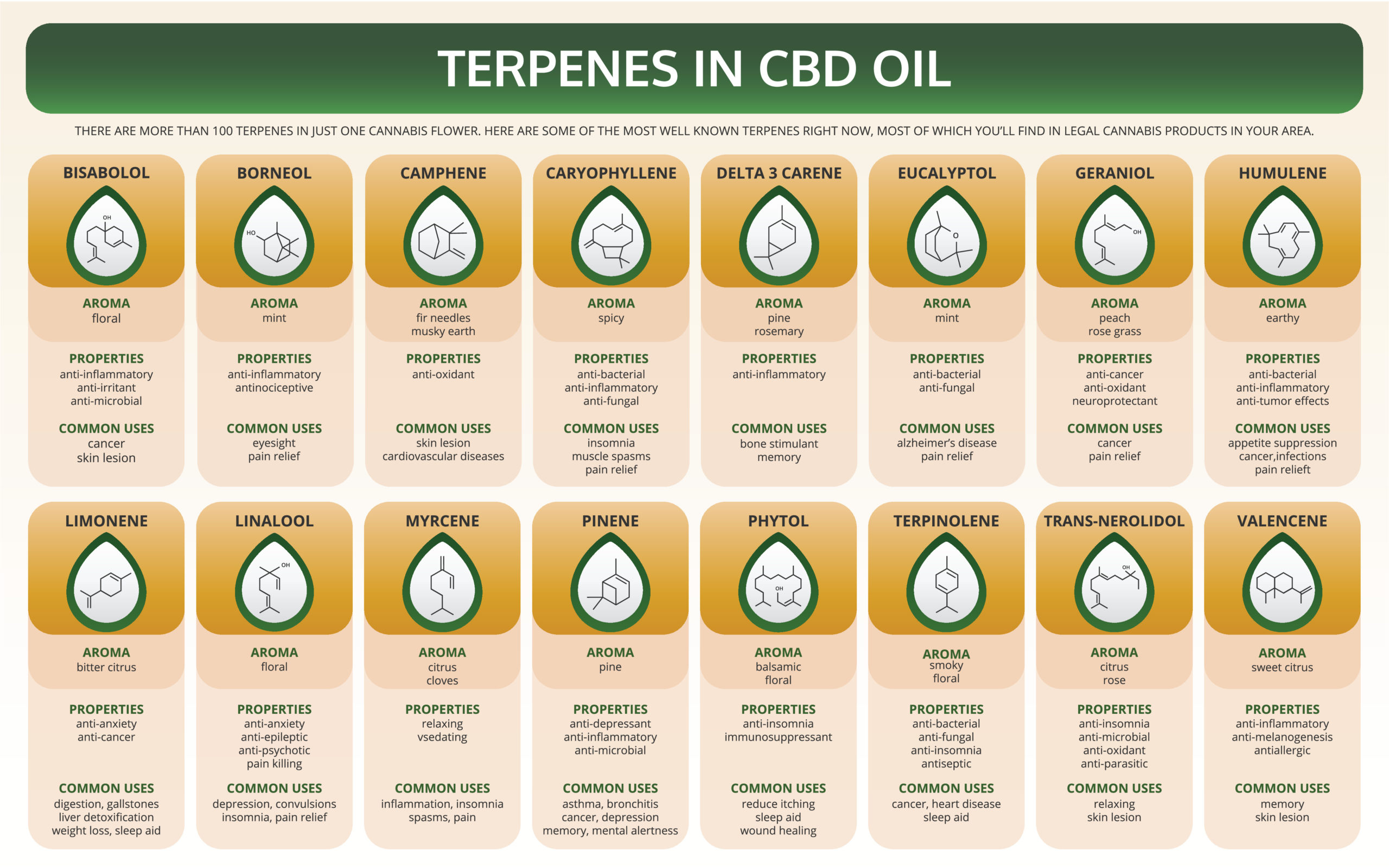- Empty cart.
- Continue Shopping
Terpinolene what is it
Terpinolene is only one of over two hundred terpenes produced by the cannabis plan this molecular structure appears in many modern cannabis chemovars but in very low quantities and normally occurs in Sativa type plants.
Terpinolene is a small and simple molecules known as a monoterpene, these two isoprene units define its molecular type, and place it into this category alongside the likes of myrcene and limonene .
Terpinolene is especially responsible for the pungent smell or aroma of the cannabis plant even though it is only in a very small amount, terpinolene gives the sweet smell but is also used as an insecticide, but humans seem to enjoy the smell.
Terpinolene produced by cannabis plants with other terpenes and cannabinoids these defend against fungal pathogens, pest insects and other nasty bugs and blights.
This is well documented in this report capabilities of larvicidal and antifungal they are very small molecules, but it’s full of promise. Terpinolene’s has massive therapeutic potential but ongoing research is not conclusive, it is thought that terpinolene could be one of the medicinal molecules that halls cannabis have its soothing properties.
Further more let us have closer look at terpinolene and its special qualities, anyhow this terpene could benefit our science.
Aroma
The terpinolene aroma is fresh and pungent with an earthy smell with a hint of pine this terpene give wafts of flowers, herbs, pine, wood and of citrus many companies use it in making bars of soap and perfume.
You can also find it in
The molecule also naturally occurs in varying concentrations in Scots pine, nutmeg, sweet marjoram, valerian, narrow-leaf tea, tree, celery, , oregano, cilantro, rosemary, sweet basil, sage, and ginger.
Terpinolene can be found in it highest levels of concentration in Wild parsnips The essential oil of the plant contains around 69% of the chemical.

What are the possible effects
As it is still in the early stages of research these are not fully known but terpinolene is thought to show some effects which are assumed to be therapeutic but the science cannot be proved due to lack of trials in humans.
Although trails in humans have not yet begun studies on animals and studies of the effects of terpinolene cell research can reveal the suspected effects on humans.
So far, the terpene appears to produce the following effects:
Analgesic
Anti-inflammatory
Possible sedative
Antitumour
Antioxidant
May protect against cardiovascular diseases
Anti Cancer
There have been many studies have demonstrated terpinolene can have an effect on cancerous cells the molecule appears to signalling between the pathways that prompt the survival and growth of cancer cells which has been a major breakthrough.
Some search that has been published in the journal “Oncology Letters” depicts how terpinolene achieves these effects in this Paper.
AKT protein also known as protein kinase B, AKT shows that terpinolene the terpene to be effective at reducing the expression of a protein kinase known as AKT which when treated with terpinolene can slow cancer progression in opposition protein kinase B, AKT, as it contributes to cancer progression by way of mediating cell proliferation and survival signals, AKT is implicated in numerous types of human cancers.
Sage and rosemary also contain the terpene, terpinolene can reduce expression of the protein kinase further supporting its anti cancer properties the studies found that terpinolene is an active constituent of both plant species and cannabis which can contribute to these effects.
Further research published in 2013 ran tests on rats tested terpinolene on the proliferation of rat brain tumour cells. Researchers found the terpene to produce significant effects when administered to neuroblastoma cells. They concluded that terpinolene produces potent antiproliferative effects and may have potential use as an anticancer agent as shown by this research.
Antioxidant?
The reach points to strong evidence that terpinolene may also have potential as a strong antioxidant, the journal of “Cytotechnology” tested out the effects of terpinolene on human lymphocytes a subtype of white blood cells with good effects as shown in this Research.
In the research the scientists exposed the cells to the terpenes for periods of 24 and 48 hours and found that antioxidant activity, along with no genotoxic effects concluded that terpinolene due to its antioxidant activities shown as a “new resource of therapeutics”.
The molecule may also reduce both pain and swelling during a 2016 study paper published “Brazillian Journal of Medical and Biological Research” found the terpene to work in similar ways with common anti-inflammatory drugs.
During the research on mice they were administered a blend of terpinolene and (NSAID) Diclofenac a non-steroidal anti-inflammatory drug (NSAID) Diclofenac . The two together showed reduction in inflammation and pain by acting on serotonin receptors they also showed no issues in the digestion tract, which can be an effect of NSAIDs.
Cardiovascular effects
Terpinolene could help to protect against cardiovascular conditions the molecule may help to protect against the oxidation of low-density lipoprotein (LDL) this is known as the “bad” type of cholesterol. LDL can build up in the arteries and veins and contribute to heart attacks and strokes as shown in this research. It does this by reducing the oxidation of LDL which in turn reverses the hardening of arteries , terpinolene may help to prevent such diseases.


